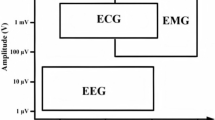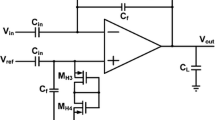Abstract
A cardiac biomarker (CB) is an important substance released into the blood during heart damage. CB measurements help in the detection of concentric levels in cardiac troponin I. The increased troponin level in the blood can lead to the major cause of cardiac injury. Hence it is necessary to monitor the troponin level of blood. Accurate troponin I detection sensors detect the troponin level in blood. The biosensor signal is converted into an electrical signal of very low voltages. However, these electrical signals are too low. Hence, a bio-medical amplifier is introduced with analog to digital converters and compressors to amplify, capture, transfer and digitize the biosensor signal with less power and area consumption. A bio-amplifier is presented with programmable bandwidth and gain, but the task is challenging. Hence, a fully balanced bio-medical gain amplifier using a two-level CNTFET based operational amplifier (op-amp) (BGA-2C-opamp) is proposed in this work. This particular work uses two stages of CNTFET-based op-amp and presents an input capacitor for blocking the DC offset voltages. This coupling input capacitor operates the bio-medical amplifier gain using an extra load capacitor at the output. The coupling feedback resistor and capacitor are used in this amplification stage to provide a small pole frequency. The proportion of input and the feedback capacitors determines the gain of the amplification stage. To develop a two stage CNTFET-based op-amps, the trans-conductance to drain current ratio measurement is used in this case. Moreover, the bias currents of the quasi-resistors used in the feedback circuit are adjusted to achieve the cut-off programmability. The proposed BGA-2C op-amps are carried out in the cadence Virtuoso tool and analyze the proposed system’s effectiveness in magnitude response, phase response, transient response, gain, total harmonic distortion, input referred noise, phase margin, common mode rejection ratio and power supply rejection ratio. In addition to this, the performance measures of delay (D), power (p) and power delay product are examined under different chirality vectors; also, the Monte Carlo analysis is examined.

















Similar content being viewed by others
Data availability
Data sharing does not apply to this article.
Reference:s
Aichinger, T., Rescher, G., & Pobegen, G. (2018). Threshold voltage peculiarities and bias temperature instabilities of SiC MOSFETs. Microelectronics Reliability, 80, 68–78.
Bendre, V., & Kureshi, A.K. (2016). Performance analysis of operational transconductance amplifier at 180 nm technology. In: 2016 Second International Innovative Applications of Computational Intelligence on Power, Energy and Controls with their Impact on Humanity (CIPECH), IEEE 271–276.
Lagos, J., Hershberg, B., Martens, E., Wambacq, P., & Craninckx, J. (2018). A single-channel, 600-MS/s, 12-b, ringamp-based pipelined ADC in 28-nm CMOS. IEEE Journal of Solid-State Circuits, 54(2), 403–416.
Song, Y. (2016). Multigate MOSFETs for digital performance and high linearity, and their fabrication techniques. University of Illinois at Urbana-Champaign.
Rai, M. K., Gupta, A., & Rai, S. (2022). Comparative analysis & study of various leakage reduction techniques for short channel devices in junctionless transistors: A review and perspective. Silicon, 14(9), 4423–4445.
Arul, P., & Prabha, K. H. (2021). A comprehensive analysis of short channel effects on carbon nano tube field effect transistors. Journal of Nanoelectronics and Optoelectronics, 16(12), 1905–1912.
Prakash, P., Sundaram, K. M., & Bennet, M. A. (2018). A review on carbon nanotube field effect transistors (CNTFETs) for ultra-low power applications. Renewable and Sustainable Energy Reviews, 89, 194–203.
Ratnesh, R. K., Goel, A., Kaushik, G., Garg, H., Singh, M., & Prasad, B. (2021). Advancement and challenges in MOSFET scaling. Materials Science in Semiconductor Processing, 134, 106002.
Li, Z., Jinkins, K. R., Cui, D., Chen, M., Zhao, Z., Arnold, M. S., & Zhou, C. (2022). Air-stable n-type transistors based on assembled aligned carbon nanotube arrays and their application in complementary metal-oxide-semiconductor electronics. Nano Research, 15(2), 864–871.
Moradi, M., Tao, S., & Mirzaee, R.F. (2017). Physical unclonable functions based on carbon nanotube FETs. In: 2017 IEEE 47th International Symposium on Multiple-Valued Logic (ISMVL). IEEE, pp 124–129.
Sharma, T., & Kumre, L. (2020). Design of low power multi-ternary digit multiplier in CNTFET technology. Microprocessors and Microsystems, 73, 102959.
Waykole, S., & Bendre, V.S. (2018). Performance analysis of classical two stage op-amp using CMOS and CNFET at 32 nm technology. In: 2018 fourth international conference on computing communication control and automation (ICCUBEA). IEEE, pp 1–6
Salavati, S., Moaiyeri, M. H., & Jafari, K. (2021). Ultra-efficient nonvolatile approximate full-adder with spin-Hall-assisted MTJ cells for in-memory computing applications. IEEE Transactions on Magnetics, 57(5), 1–11.
Naderi, A., & Tahne, B. A. (2016). Methods in improving the performance of carbon nanotube field effect transistors. ECS Journal of Solid State Science and Technology, 5(12), M131.
Dhiman, R., & Chandel, R. (Eds.). (2020). Nanoscale VLSI: Devices, circuits and applications. Springer Nature.
Mehrabani, Y. S., & Eshghi, M. (2016). Noise and process variation tolerant, low-power, high-speed, and low-energy full adders in CNFET technology. IEEE Transactions on Very Large Scale Integration (VLSI) Systems, 24(11), 3268–3281.
Saha, J. K., Chakma, N., & Hasan, M. (2018). Impact of channel length, gate insulator thickness, gate insulator material, and temperature on the performance of nanoscale FETs. Journal of Computational Electronics, 17(4), 1521–1527.
Jooq, M. K. Q., Bozorgmehr, A., & Mirzakuchaki, S. (2021). An ultra-miniature broadband operational transconductance amplifier utilizing 10 nm wrap-gate CNTFET technology. Analog Integrated Circuits and Signal Processing, 107(2), 423–434.
Bendre, V., Kureshi, A. K., & Harpale, V. (2022). A low-power positive feedback operational amplifier using carbon nanotube field effect transistor. ICCCE 2021 (pp. 923–930). Springer.
Hills, G., Lau, C., Wright, A., Fuller, S., Bishop, M. D., Srimani, T., Kanhaiya, P., et al. (2019). Modern microprocessor built from complementary carbon nanotube transistors. Nature, 572(7771), 595–602.
Bishop, M. D., Hills, G., Srimani, T., Lau, C., Murphy, D., Fuller, S., Humes, J., Ratkovich, A., Nelson, M., & Shulaker, M. M. (2020). Fabrication of carbon nanotube field-effect transistors in commercial silicon manufacturing facilities. Nature Electronics, 3(8), 492–501.
Mamatov, I., Özçelep, Y., & Kaçar, F. (2022). VDTA based Schmitt trigger using 32 nm CNTFET technology. Analog Integrated Circuits and Signal Processing, 112(2), 347–353.
Mamatov, İ, Özçelep, Y., & Kaçar, F. (2022). CNTFET based inductance simulator circuits employing single CFOA and its filter applications. Analog Integrated Circuits and Signal Processing, 111(2), 235–242.
Mamatov, I., Özçelep, Y., & Kaçar, F. (2021). CNTFET based voltage differencing current conveyor low power and universal filter. Analog Integrated Circuits and Signal Processing, 1–11.
Ho, R., Lau, C., Hills, G., & Shulaker, M. M. (2019). Carbon nanotube CMOS analog circuitry. IEEE Transactions on nanotechnology, 18, 845–848.
Prokopenko, N., Budyakov, P., Bugakova, A., & Titov, A. (2022). Op-Amps without current mirrors based on depletion-mode p-and n-channel MOS and JFET. Analog Integrated Circuits and Signal Processing, 113(1), 119–127.
Kumari, S., & Gupta, M. (2017). New CMOS realization of high performance voltage differencing inverting buffered amplifier and its filter application. Analog Integrated Circuits and Signal Processing, 92(1), 167–178.
Rezaeii, A.B., Dadashi, K., & Mahdavi, S. (2016). Gain-bandwidth enhancement in folded-cascode op-amp. In: 2016 1st International Conference on New Research Achievements in Electrical and Computer Engineering.
AbuShawish, I.Y., & Mahmoud, S.A. (2021). Constant tera-ohm pseudo-resistor over wide dynamic range. In 2021 IEEE International IOT, Electronics and Mechatronics Conference (IEMTRONICS), IEEE, pp 1–6.
Puri, A., & Rana, A. (2015). Performance analysis of CNTFET based low power operational amplifier in analog circuits for biomedical applications. In: 2015 IEEE International Conference on Electronics, Computing and Communication Technologies (CONECCT), IEEE, pp 1–5.
Bendre, V. S., Kureshi, A. K., & Waykole, S. (2018). Design of analog signal processing applications using carbon nanotube field effect transistor-based low-power folded cascode operational amplifier. Journal of Nanotechnology, 2018, 1–15.
Zang, J., Zhang, H., Sun, Q., & Zhang, R. (2018). A low-noise, low-power amplifier with current-reused OTA for ECG recordings. IEEE Transactions on Biomedical Circuits and Systems, 12(3), 700–708.
Huang, Y. J., Tzeng, T. H., Lin, T. W., Huang, C. W., Yen, P. W., Kuo, P. H., Lin, C. T., & Lu, S. S. (2014). A self-powered CMOS reconfigurable multi-sensor SoC for biomedical applications. IEEE Journal of Solid-State Circuits, 49(4), 851–866.
Cen, M., Song, S., & Cai, C. (2017). A high performance CNFET-based operational transconductance amplifier and its applications. Analog Integrated Circuits and Signal Processing, 91, 463–472.
Garg, S., & Gupta, T. K. (2019). Low leakage domino logic circuit for wide fan-in gates using CNTFET. IET Circuits, Devices & Systems, 13(2), 163–173.
Yasir, M., & Alam, N. (2020). Systematic design of CNTFET based OTA and Op amp using gm/ID technique. Analog Integrated Circuits and Signal Processing, 102(2), 293–307.
Carbon nanotube field effect transistors (CNFET) hspice model v. 2.2.1, Stanford University. Retrieved June 6, 2018, from http://nano.stanford.edu/models.php
Joshy, V. Z., Prasath, R. A., Ravi, T., & Karman, V. (2012). Design and analysis of compressors using CNTFET. In: 2012 International Conference on Emerging Trends in Science, Engineering and Technology (INCOSET), IEEE, pp 323–328.
AbuShawish, I. Y., & Mahmoud, S. A. (2021). A programmable gain and bandwidth amplifier based on tunable UGBW rail-to-rail CMOS op-amps suitable for different bio-medical signal detection systems. AEU-International Journal of Electronics and Communications, 141, 153952.
Khade, A. S., Vyas, V., & Sutaone, M. (2019). A technique to enhance the transconductance of micro-power improved recycling folded cascode operational transconductance amplifier with reasonable phase margin. AEU-International Journal of Electronics and Communications, 108, 148–157.
Feizbakhsh, S. V., & Yosefi, G. (2019). An enhanced fast slew rate recycling folded cascode Op-Amp with general improvement in 180 nm CMOS process. AEU-International Journal of Electronics and Communications, 101, 200–217.
Wang, J., Zhu, Z., Liu, S., & Ding, R. (2017). A low-noise programmable gain amplifier with fully balanced differential difference amplifier and class-AB output stage. Microelectronics Journal, 64, 86–91.
Funding
No funding is provided for the preparation of manuscript.
Author information
Authors and Affiliations
Contributions
All authors read and approved the final manuscript.
Corresponding author
Ethics declarations
Conflict of interest
Authors declare that they have no conflict of interest.
Ethical approval
This article does not contain any studies with human participants or animals performed by any authors.
Consent to participate
All authors have agreed to participate in this submitted article.
Consent to publish
All the authors involved in this manuscript give full consent for publication of this submitted article.
Additional information
Publisher's Note
Springer Nature remains neutral with regard to jurisdictional claims in published maps and institutional affiliations.
Rights and permissions
Springer Nature or its licensor (e.g. a society or other partner) holds exclusive rights to this article under a publishing agreement with the author(s) or other rightsholder(s); author self-archiving of the accepted manuscript version of this article is solely governed by the terms of such publishing agreement and applicable law.
About this article
Cite this article
Shailaja, J., Prabhakar, V.S.V. A programmable gain amplifier based on a two-level CNTFET op amp with optimized trans-conductance to drain current ratio. Analog Integr Circ Sig Process 118, 355–369 (2024). https://doi.org/10.1007/s10470-023-02239-8
Received:
Revised:
Accepted:
Published:
Issue Date:
DOI: https://doi.org/10.1007/s10470-023-02239-8




